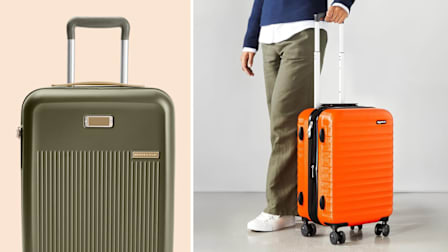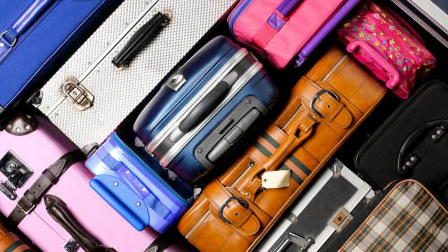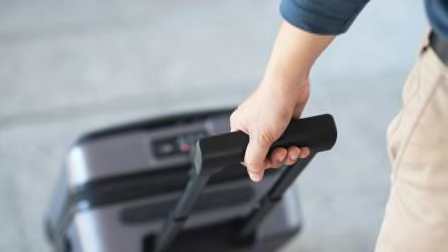Smart Ways to Protect Your Luggage
How to guard against damage and theft when you travel

If you’re planning to travel this summer, it’s probably time to take a close look at your luggage.
Don't assume nothing bad can happen to your shiny new bag. U.S. airlines mishandled 1.8 million checked bags last year, up from 1.6 million the previous year, according to the latest Air Travel Consumer Report from the U.S. Department of Transportation. That includes luggage that was lost, damaged, or ransacked—or even stolen outright.
Percentage-wise, that equals around three claims per 1,000 passengers, which might sound small—except that each one of those errant bags represents a potentially ruined vacation.
The truth is that travel can be harder on your luggage than it is on you. And travelers are shelling out more to transport it. Last year, U.S. airlines collected $4.9 billion in checked bag fees, up from $4.6 billion in 2017—and more than quadruple what it was 10 years ago.
So how can you ensure that you’ll get your money’s worth? Here, nine strategies to improve the odds that your bag and the belongings it contains will survive the journey unscathed.
Cover Story
Consider baggage wrapping services. Ever spot a suitcase at an airport covered in what looks like heavy Saran wrap? A number of companies, such as Secure Wrap, offer bag wrapping services at major international airports for fees starting at $15 for a standard-sized suitcase.
The benefit is that your bag will be better protected from damage and pilfering of its contents. The downside is that if the TSA needs to look inside, it will cut right through that airtight seal, and the agents won’t rewrap it. And if you have soft-sided bag luggage, it can be tricky to remove the wrap without also slicing into your bag.
Protective covers. A simple way to guard against scratches and dings is to buy a protective sleeve to encase your bag. There are a slew of products to choose from, ranging from clear plastic sleeves to patterned fabric wrappers, and luggage manufacturers such as Hartmann are getting into this game.
These accessories reduce the odds of plain old damage, and they might also make the bag less tempting to thieves—although keep in mind that they’re not impregnable.
Think pink. Sometimes your bag may go astray simply because it looks like everyone else’s, and a fellow passenger can innocently walk off with your stuff. (Although in that case, you’ll usually get it back, but it can still be a major annoyance.)
If you, like many travelers, still prefer black luggage, then think about adorning your bag with a brightly colored ribbon, luggage stickers, or yellow duct tape. If you’re getting a new bag, consider a bright color or print. You don’t have to spend a lot of money for a distinctive looking bag. In fact, you probably shouldn’t: A bag that is too expensive-looking could be a magnet for thieves.
Extra Protection
Sign up for bag tracking. Airlines are getting better at tracking your bag at every stage of the trip, and some carriers, like Delta, will let you do this yourself through a mobile app. The idea is that your checked bag will be scanned at four points during the trip: check-in, loading onto the plane, during a transfer from one flight to another, and upon arrival at the final destination. (The International Air Transport Association, which represents 290 airlines that carry roughly 82 percent of the world’s air traffic, has set a goal of making this an industrywide practice.)
There are also GPS-powered devices that you can buy yourself to follow your bag, and some luggage comes equipped with them. However, be aware that the airlines have been clamping down on “smart” luggage due to the risk of batteries overheating.
Entrust it to a shipping or storage service. You can spare your bag the indignities of air travel and ship it ahead. While this may cost a bit more than checking it (though it doesn't always), it can give you peace of mind and reduce the wear and tear. If you have a long layover, you can make it less stressful by using a short-term storage service.
Look into excess valuation. If something happens to your bag, the airline you entrusted it to is responsible for making it right—but only up to a certain point. In the U.S., the airlines are liable for up to $3,500 in compensation for lost or damaged baggage—and that’s for the cost of the luggage itself and all the contents. On international flights, the limits are even less generous: Under an aviation treaty, it’s set at about $1,600 per checked item. But if you believe that what you're hauling is worth more, then consider purchasing excess valuation from the airline. Technically, it’s not insurance, but it does increase the maximum amount of what the airline would owe you. (And your homeowners insurance may also cover some of your losses, so check your policy.)
Keep records of what you packed. Write it all down, store it in your mobile device—or simply photograph the contents. This will help if you have to confirm that an item is missing and need to file a claim with the airline for a lost or damaged bag.
































